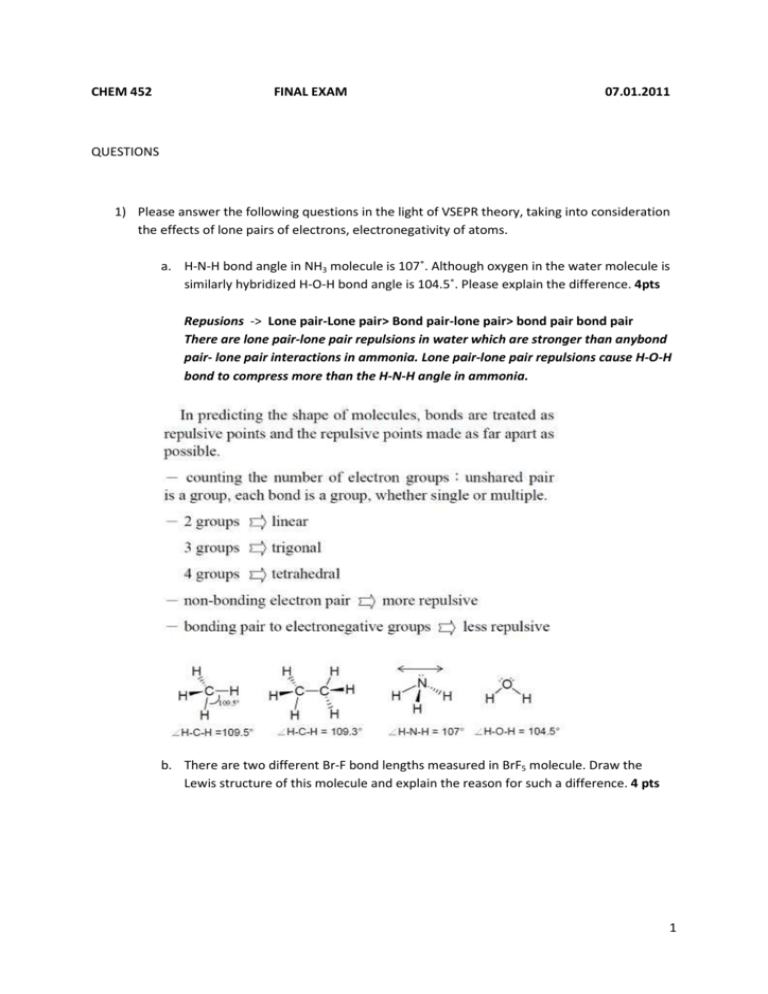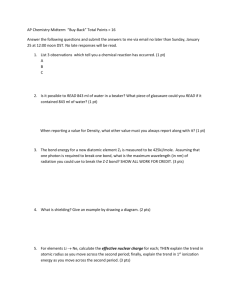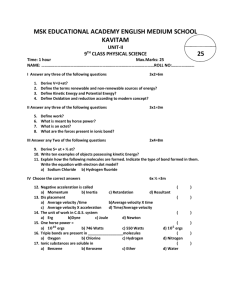Answer
advertisement

CHEM 452 FINAL EXAM 07.01.2011 QUESTIONS 1) Please answer the following questions in the light of VSEPR theory, taking into consideration the effects of lone pairs of electrons, electronegativity of atoms. a. H-N-H bond angle in NH3 molecule is 107˚. Although oxygen in the water molecule is similarly hybridized H-O-H bond angle is 104.5˚. Please explain the difference. 4pts Repusions -> Lone pair-Lone pair> Bond pair-lone pair> bond pair bond pair There are lone pair-lone pair repulsions in water which are stronger than anybond pair- lone pair interactions in ammonia. Lone pair-lone pair repulsions cause H-O-H bond to compress more than the H-N-H angle in ammonia. b. There are two different Br-F bond lengths measured in BrF5 molecule. Draw the Lewis structure of this molecule and explain the reason for such a difference. 4 pts 1 c. Comment on order of the X-S-X bond angles in three molecules with the general molecular formula of SOX2 where X=F,Cl,and Br. Please explain your reasoning briefly (Draw the Lewis structures first and then put them in the order of increasing bond angles). 4 pts d. Draw the correct Lewis structure of PClF4 molecule and comment on bond lengths. 4pts 2) The H-C-Cl bond angle in CH3Cl molecule is measured to be 108˚. a. Would you expect H-C-F bond angle in CH3F molecule larger or smaller than this value? Explain why? 4 pts Because of the greater electronegativity of Fluorine atom compared to Chlorine atom, we might expect the C-F bond to utilize even greater p-character on carbon than does the C-Cl 2 bond in CH3Cl. This should decrease the H-C-F angle even more than the H-C-Cl bond angle in CH3Cl. b. If the H-C-H bond angle in CH3F molecule110.2˚, calculate the H-C-Fl bond angle. 4 pts iHH= -1/ Cos θHH => iHH= -1/ Cos 110.2˚ => iHH=2.896 3(1/1+ iHH)+ (1/1+ iHF)=1 => iHF=3.348 Cos θHH =-1/ iHF= 107.4˚ c. Calculate the percent s-character (%s) for the carbon hybrid orbitals in C-H bonds if the C-H coupling constant (J 13C-H) is 134 Hz in its 13C-NMR spectrum. 4 pts J 13C-H= 134 Hz= 500 s(i) where s(i) = % s character on carbon hybrid orbitals in C-H bonds. s(İ)=134/500=0.268 => %s character=26.8 3) Although oxygen is more electronegative than bromine, the dipole moment of CH3OH molecule is smaller than dipole moment of CH3Br molecule. Explain why? 6 Pts A dipole moment (µ) is given in units of electrical charge times distance (Eq. 1.2), where q is charge which is related to electronegativity difference between atoms making the bond and r is bond distance. (µ = q x r ). The most polar bonds in CH3OH and CH3Br molecules are C-O bond and C-Br bond. Although electronegativity difference in C-O bond (q value) is much greater than that in C-Br bond, the C-Br bond is much larger and this compensates for the lower q value dipole moment for 3 this bond and rendering µ C-Br > µ C-O. In addition the higher dipole moment arising from 3 –lone pair electrons in CH3Br rather than 2-lone pairs in CH3OH further reinforces the molecular dipole moment as seen in the figure above. 4) Sketch a diagram showing the formation of a π and π* molecular orbitals (MOs) from 2p atomic orbitals (AOs)in an ethylene molecule. Also sketch a diagram showing the formation of the formation of a σ and σ* MOs from the appropriate carbon hybrid orbital and 1s AO of hydrogen in ethylene. 8 pts 5) In the following reaction (Stork Reaction) structure A is the only product and no structure B is formed as a result of this reaction. (Hint: This reaction involves the formation of one of the intermediate products shown as structure C and D). 8 pts H N O 1) , H+ O O not 2) CH3CH2Br A B NR2 NR2 C D 4 6) Answer the following questions related to carbanions: a. How can the relative stabilities of carbanions be compared? We can use the pKa values of the anions’ conjugate acids since pKa=-Log ([H+ ][A-]/[H-A]) = Log ([H-A] /[H+ ][A-]) and inversely proportional to the carbanion concentration, [A-]. The [A-] is proportional to carbanions stability. Therefore, as pKa increases the lower the stability of the carbanions. b. Compare the relative stabilities of cyclopentadienyl anion (A) and cyclopropenyl anion (B). Provide an explanation for your proposed trends in their relative stabilities. 5 c. Compare the relative stabilities of acetylide anion (C) and vinylidine anion (D). Provide an explanation for your proposed trends in their relative stabilities. 7) Hydride ion affinities (HIA) of two norbornyl cations are given below. Although they are also considered to be secondary and tertiary carbocations, the stability difference is only 6 kcal/mol. Compare this difference in their HIA to the difference in HIAs typically expected for regular secondary and tertiary carbocations. Explain any discrepancy from these expected values. 6 pts. The positive charge is stabilized by the hyperconjugation and delocalization of the charge due to the presence of a hybrid structure shown above. 6 8) Draw the Newman projections for the lowest energy conformations of 2,2-dimethylbutane and 2,3-dimethylbutane along the C2-C3 bond. Calculate the ΔHf s for each molecule using the Benson increments (table given at the end) including any correction to the Benson increments values which can be deduced from by looking at their Newman projections.8pts ΔHf = C-(C4)+4[C-(H3)(C)]+ C-(H2)(C2) + 2 Gauche ΔHf = 0.5+4[-10.2]+ (-4.93) + 2 (0.9)= -43.43 kcal/mol 2,3-dimethylbutane 3 Gauche interactions ΔHf = 4[C-(H3)(C)]+2[ C-(H)(C3)] + 3 Gauche ΔHf = 4[-10.2]+ 2(-1.90) + 3 (0.9)= -41.9 kcal/mol 9) Explain the term “streoelectronic effect” and how it works when deciding on the most stable conformation of 1,2 –dicloro-1-fluoroethane molecule. Sketch the energy diagram for the orbital interaction showing the electron distribution before and after the interaction leading to the relatively higher stability of this conformation. 10 pts The effect of relative spatial arrangements of orbitals on the reactivity or stability of a particular conformation is called stereo-electronic effect.-2 A conformation which places a better donor orbital and a better acceptor orbital in an anti fashion is more stable than any other possible conformation.-2 The donor ability: C-Cl> C-H> C-F (for sigma bonding orbitals)-2 The acceptor ability: C-Cl>C-F>C-H (for sigma anti-bonding orbitals)-2 Since the best donor is sigma bonding C-Cl and the best acceptor is C-Cl anti-bonding orbital, than the below conformation placing these two orbitals in anti fashion is the preferred one. 7 -2 10) Explain the term “A-value” using methyl cyclohexane conformers. Explain why the A-value is lower for methoxy (OCH3) substituted cyclohexane compared to methyl cyclohexane. Predict the A-value for trans 1-methoxy-3-methylcyclohexane molecule using Table 3.6 below. 8pts 8 Trans-1-methoxy-3-m methylcyclohexane conf ormers H H CH 3 OCH3 OCH3 H CH 3 H A B ∆GRXN= ∆GB-∆GA= -1.8- (-0.6)= -1.2 A= -∆GRXN= 1.2 11) Write a balanced isodesmic reaction to predict the aromatic stabilization of benzene molecule involving benzene, cyclohexene and cyclohexane cyclohe molecules and calculate this value using Benson increments. 10 pts (H2)(C2)]+ 2[C-(H2)(Cd)(C)]+2[ Cd-(H)(C)] = Cylohexene: ΔHf = 2[C-(H ΔHf = 2[-4.93 4.93]+ 2[-4.76]+2[ 8.59] =-9.86-9.52+17.18=-2.2 Benzene: ΔHf = 6[ Cb-(H)]] =6[3.30]=19.8 Cylohexane: ΔHf = 6[C-(H (H2)(C2)] =6[-4.93]=-29,58 ΔHrxn =ΔHf [Benzene]+ 2 ΔHf [Cyclohexane]-3 ΔHf [Cyclohexene] =Stabilization ΔHrxn = [19.8]+ 2 [-29.58]]-3[-2.2] =-32.76 kcal/mol 12) Provide the Klyne-Prelog Prelog notations for the following molecular conformations. 6pts ap +sc -sc 9 10








